Alley cropping: Growing annual crops in tilled strips between rows of a tree or shrub crop.
Biostrips: Permanent sod strips, usually of high botanical diversity, maintained to provide food and habitat for beneficial organisms and disrupt dispersal of pests.
Companion planting: A general term essentially synonymous with intercropping but often used to refer to the planting of non-crop or ornamental species with vegetables for attraction of beneficial insects.
Insectary planting: Planting strips or patches in a field with species that attract beneficial insects.
Interplanting: Intercropping.
Interseeding: Planting a direct-seeded crop into another crop, either at planting of the first crop or later, after it is established.
Living mulch: Permanent sod strips of perennial grasses or legumes between rows or beds.
Monoculture: A field with a single crop in it, or pertaining to such a field.
Nurse crop: A fast-growing crop that suppresses weeds while a slow-growing crop establishes.
Overseeding, oversowing: Planting a direct-seeded crop or cover crop into an already established crop, usually by surface sowing of the seeds.
Parasitoid: An insect that lays its eggs in or on another arthropod. The larvae develop inside the host, eventually killing it.
Polyculture: A field (or cropping system) with multiple, interacting crops, or pertaining to such a field or cropping system.
Relay (inter)cropping: Planting a second crop into an already established crop. Usually the first crop is harvested before the second matures.
Smother crop: An interseeded crop sown with the intent of smothering weeds; sometimes also applied to a weed-suppressive cover crop grown alone.
Underseeding, undersowing: Overseeding or oversowing.
